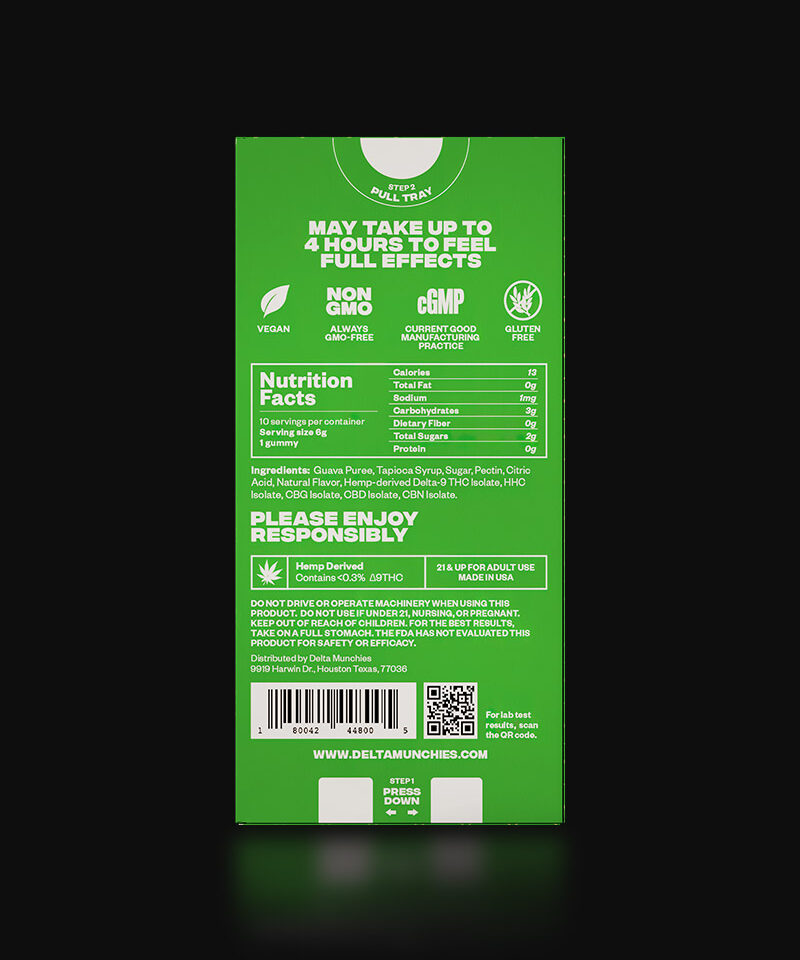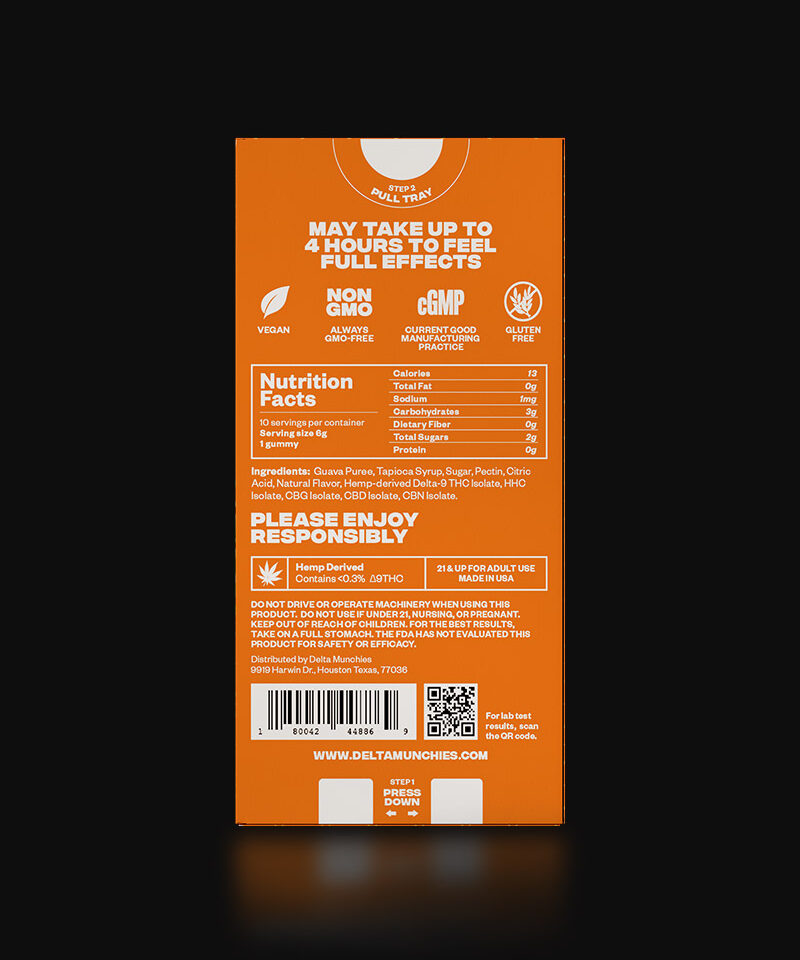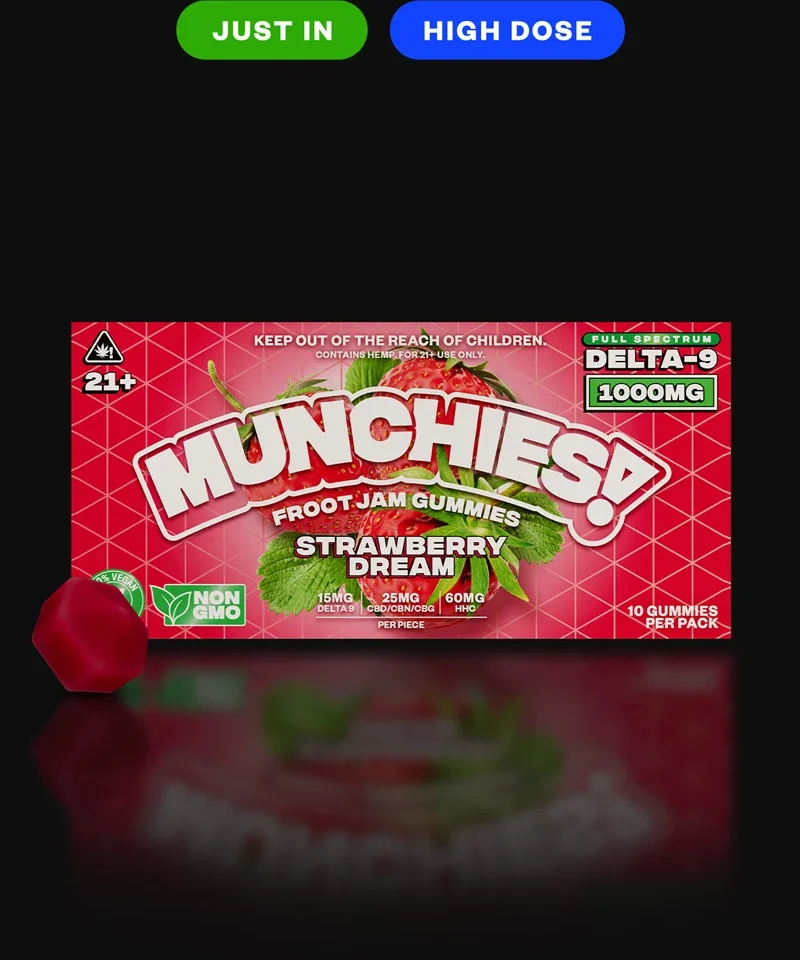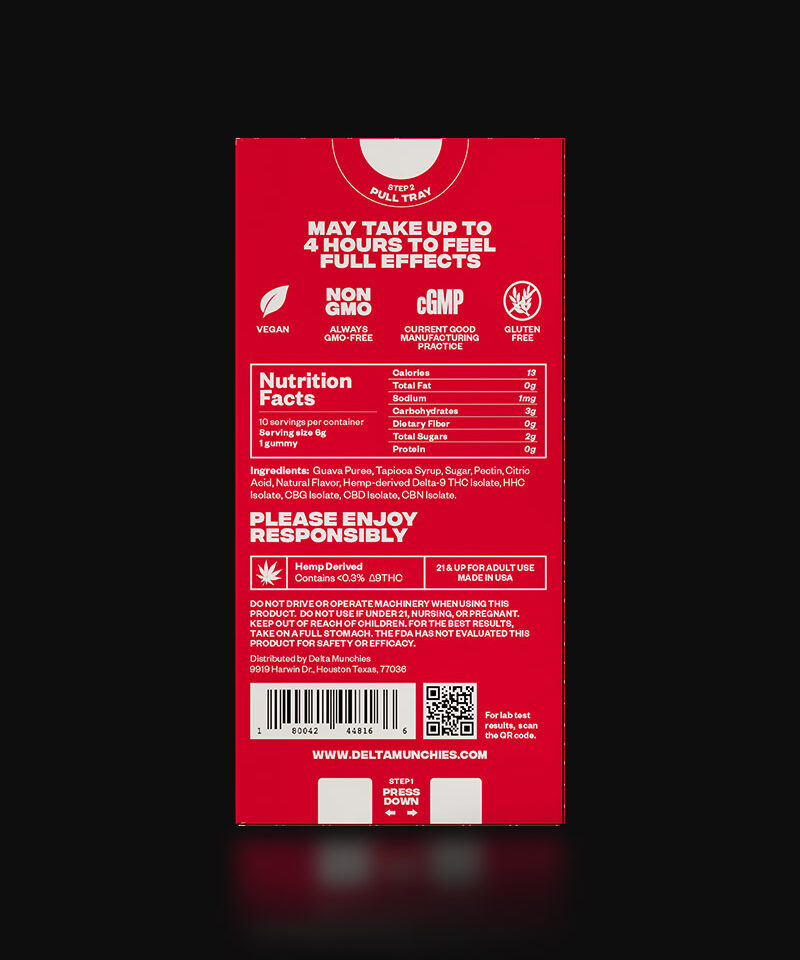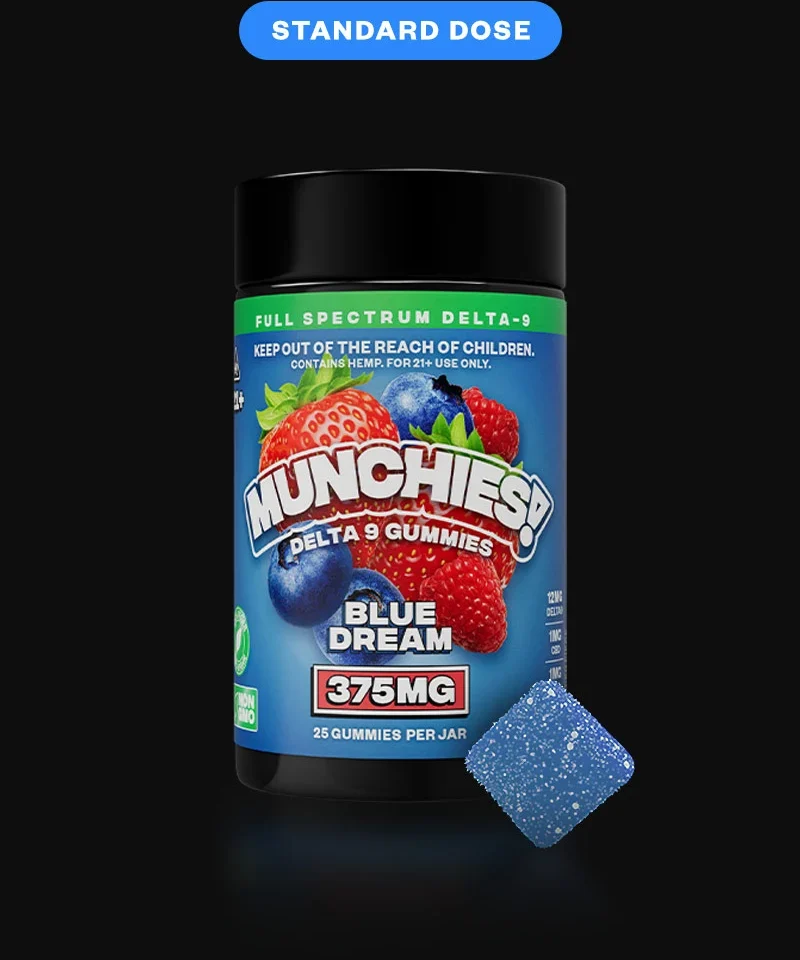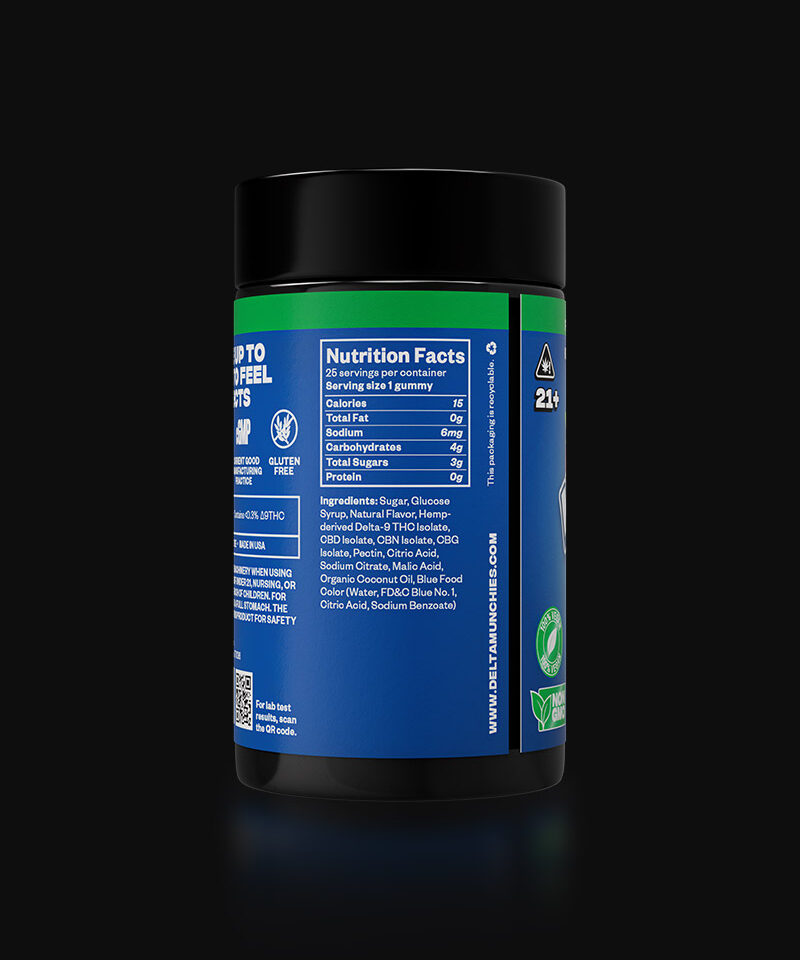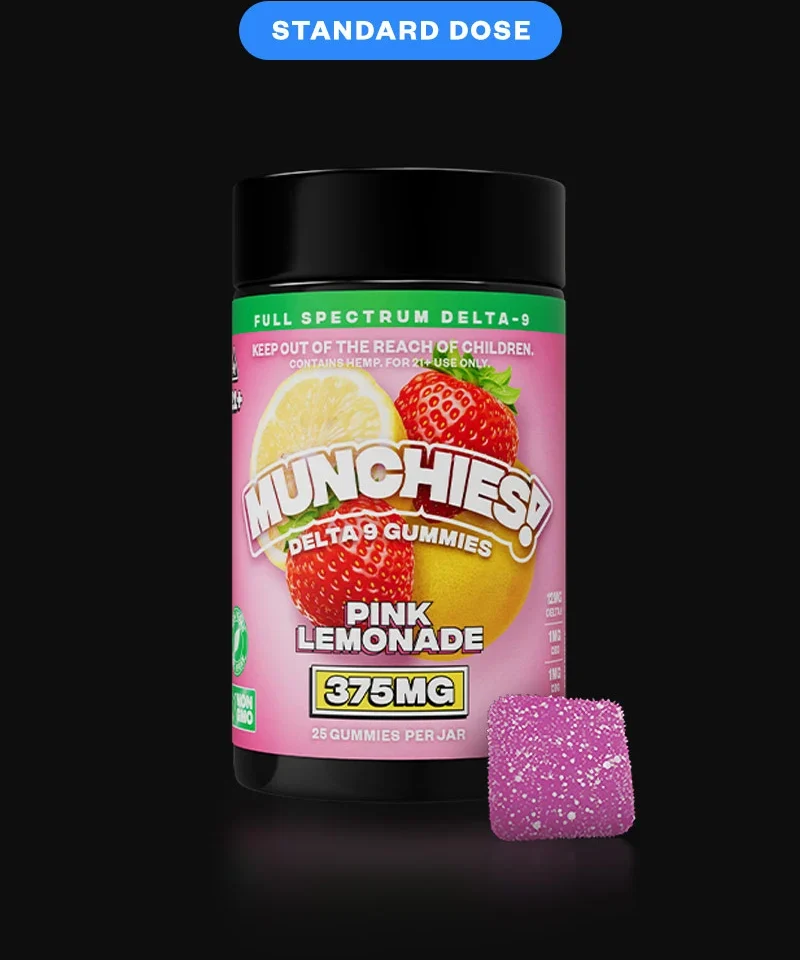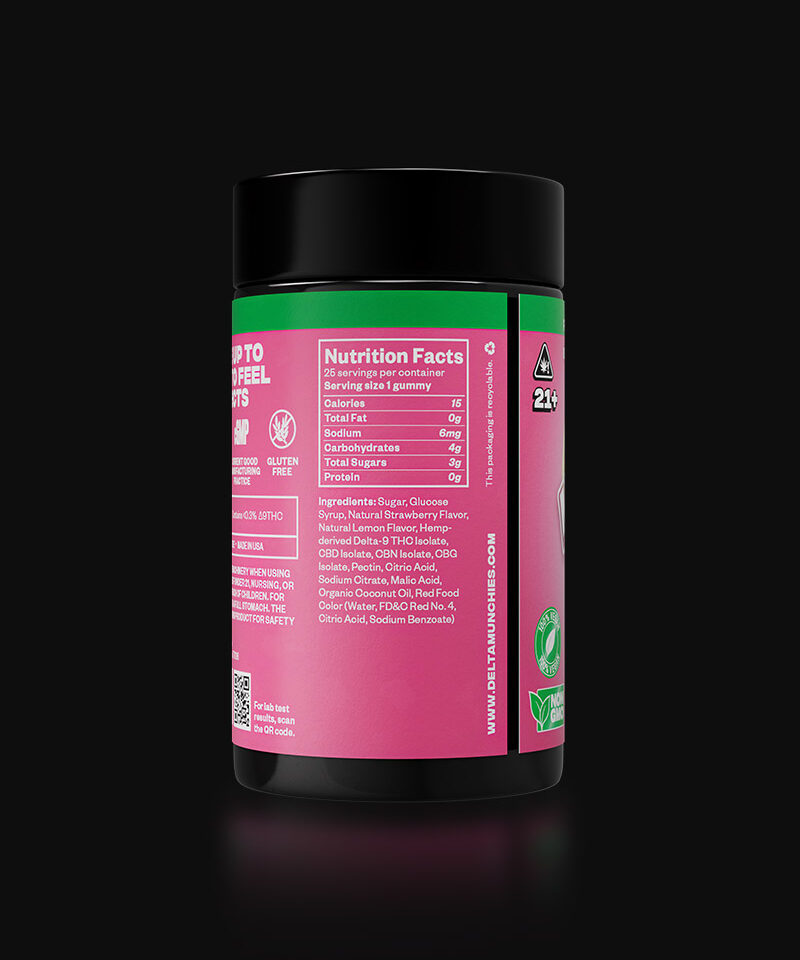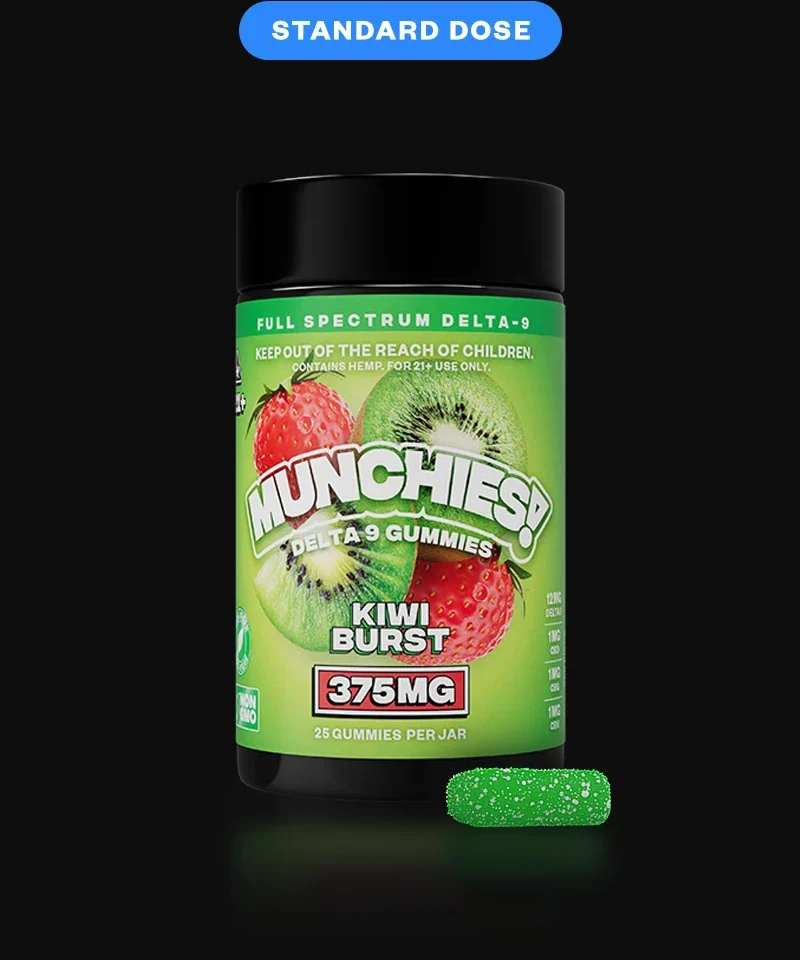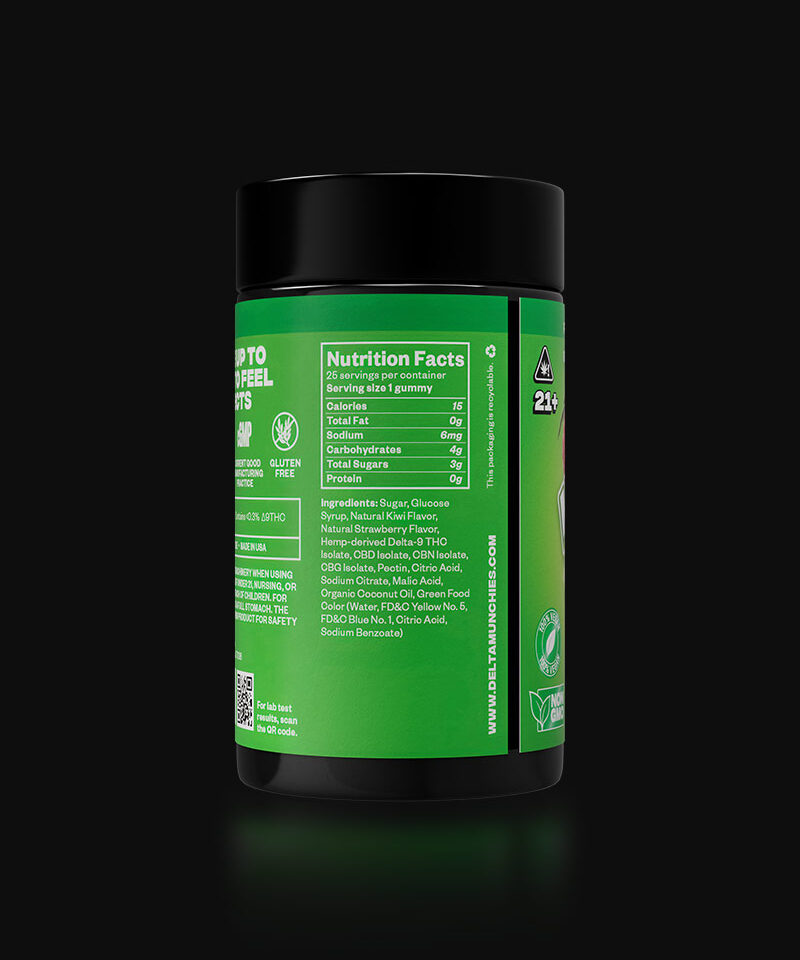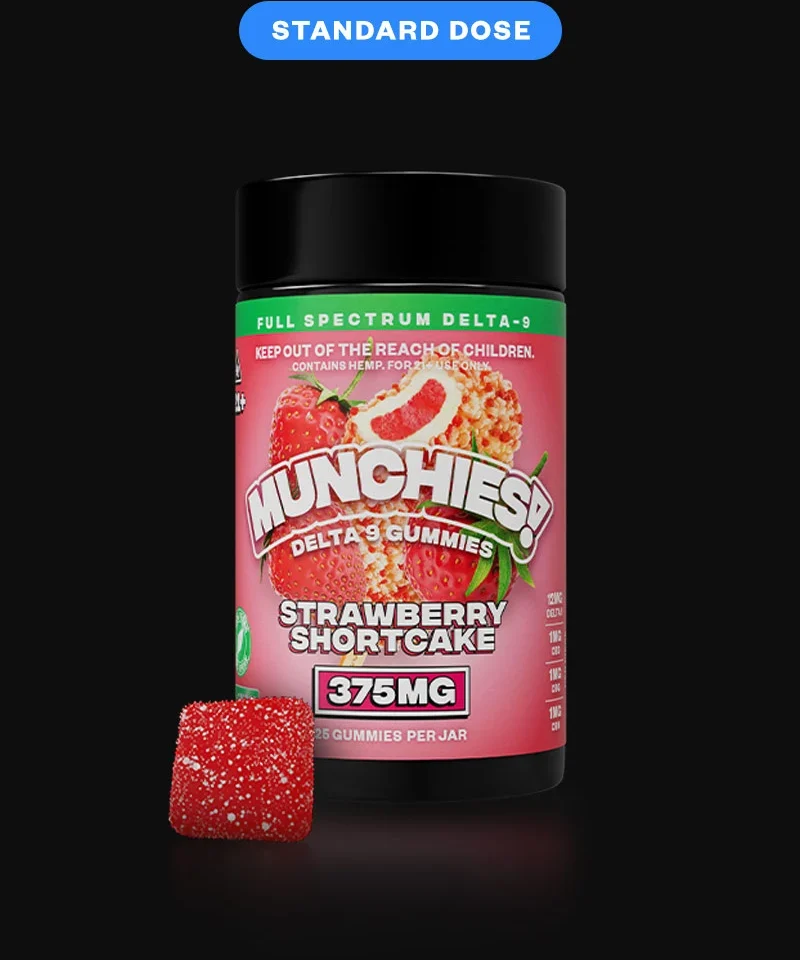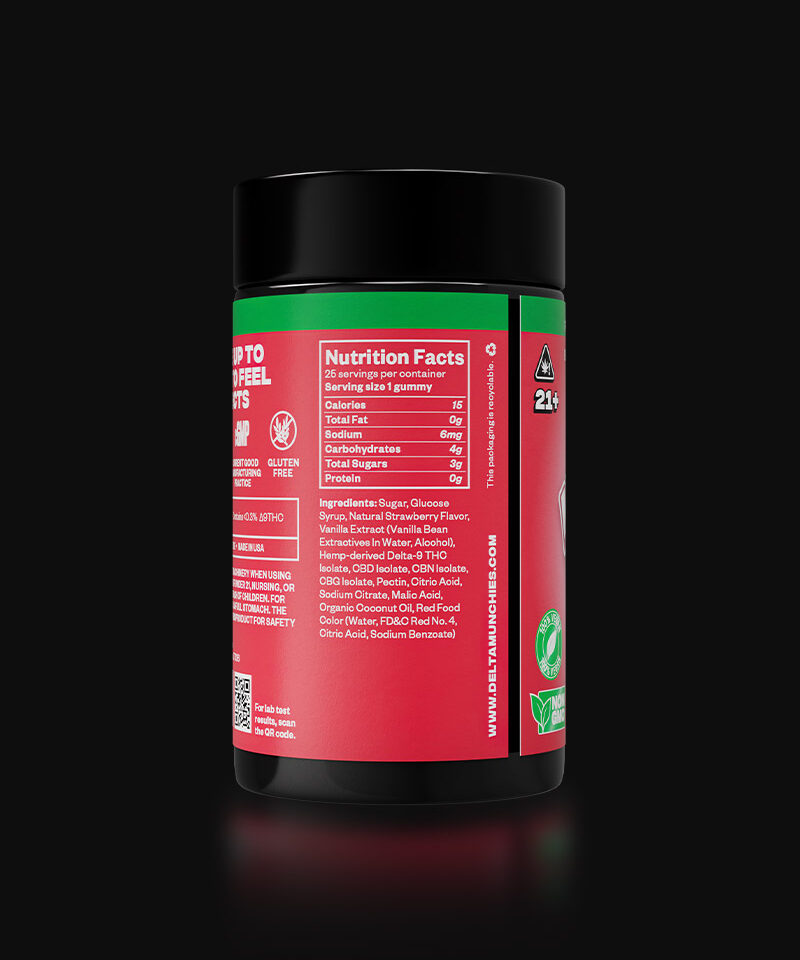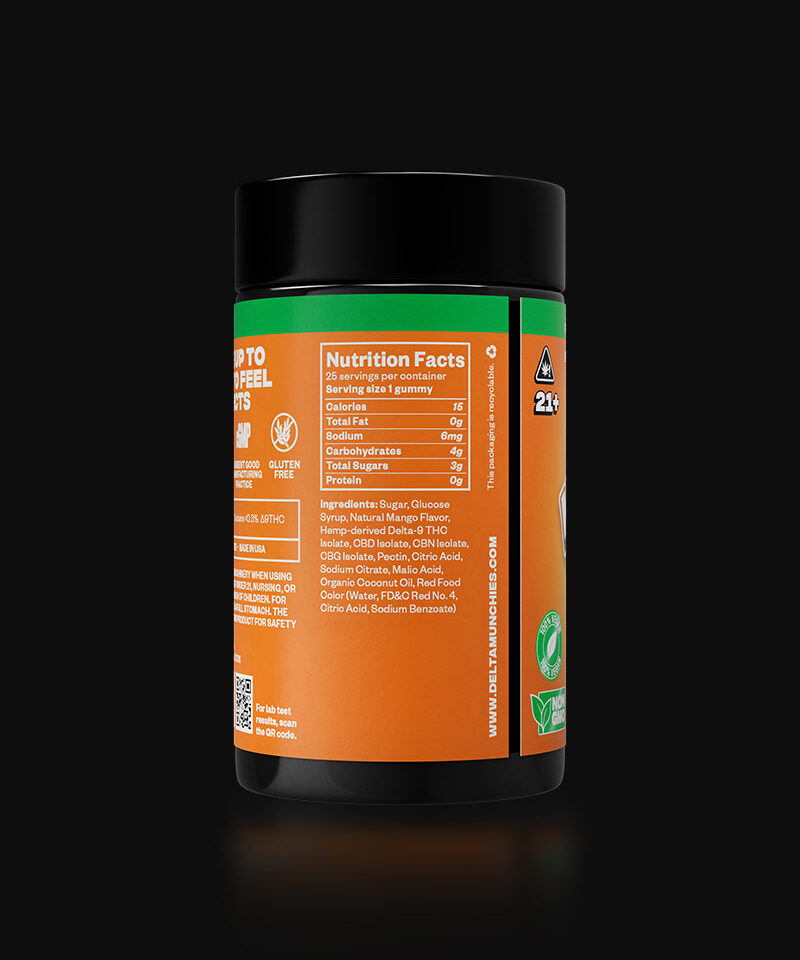Delta 9, Informative
Do Delta 9 Gummies Help Stomach Pain?
Delta 9 THC is one of the most common cannabinoids found in cannabis and hemp. And as such, many cultures and generations have used hemp for medicinal treatments and aid thanks to its potential to aid inflammation and pain.
However, nowadays, syndromes like Cannabinoid Hyperemesis Syndrome could lead new consumers to think that delta 9 THC is terrible for your stomach. Which, in reality, is not a black-and-white situation.
If you want to explore if delta 9 THC could have an analgesic effect and aid with stomach discomfort or, on the contrary, produce terrible symptoms, we’ve got you.
In this article, you’ll find the most important information to understand the difference between the different diagnoses and when this cannabinoid could be beneficial or detrimental to your health.
Looking for an unforgettable delta 9 edible? Delta Munchies has you covered.
Contents
- Key Takeaways
- What are Delta 9 Gummies?
- What is Marijuana-Related Stomach Disorder?
- What is Cannabinoid Hyperemesis Syndrome?
- What Causes CHS?
- What are the Symptoms of CHS?
- Three Main Phases of CHS
- Do Delta 9 Gummies Help Stomach Pain?
- Do Delta 9 Gummies Cause Stomach Pain?
- Where to Buy Delta 9 THC Online
- Delta 9 Gummies: FAQs
Key Takeaways
- Delta 9 THC is a psychoactive cannabinoid that has several pharmacological effects in our system.
- While rare, Cannabinoid Hyperemesis Syndrome is a diagnosis that could happen after long exposure to cannabinoids, specifically delta 9 THC.
- The most common symptoms of CHS are excessive vomiting, nausea, dizziness, and temperature changes.
- In general, delta 9 THC can aid certain digestive and abdominal area problems, like inflammation, dizziness, and nausea.
- And contrary to this, toxic doses, sensitivities, and excessive consumption can lead to CHS and other unwanted side effects.
What are Delta 9 Gummies?
Delta 9 gummies make up the big family of products called edibles. These are essentially regular foods infused with cannabis extract. In this case, the primary ingredient in the extract is delta 9—the main psychoactive compound in cannabis. It is what makes you high after taking weed.
However, legal delta 9 is obtained from hemp, not marijuana. This is according to the 2018 Farm Bill, which legalized hemp with no more than 0.3% THC concentration. If the main cannabinoid in an extract is delta 8 THC, the gummies become delta 8 gummies. These are hugely popular among cannabis users because delta 8 is weaker delta 9. Moreover, delta 8 does not produce the side effects commonly associated with delta 9.
The amount of THC in delta 9 gummies varies with the manufacturer. Most gummies contain 10-25mg of THC, which allows people with different tolerance levels to consume these edibles. Naturally, high-tolerance users can manage high-potency delta 9 gummies.
Having precise amounts of THC in gummies makes them easier to use. Once you establish what you can comfortably manage, you can modify your dosage accordingly. The rule of thumb is to start with low doses and increase gradually until you achieve your goals.
Let’s go with the basics first. Delta 9 THC is a psychoactive cannabinoid that can be found in hemp and cannabis plants, meaning it can get you high. While, in general, delta 9 THC has fairly mellow side effects, there is a newly recognized condition where frequent consumers might feel discomfort when using cannabinoid-based products.
Specifically, and thanks to how delta 9 THC interacts with our Endocannabinoid System (ECS), some unwanted side effects include vomiting and nausea. Other people have felt general discomfort in the abdominal area or pain in the lower digestive zone.
In the past, we knew very little about what caused these symptoms and how to treat them, as they were often resistant to even the strongest pain and nausea medications available. The general assessment from ER departments is based on the most common and serious diagnoses, but often none.
Because of this poor understanding of this diagnosis, patients have been preliminarily diagnosed with periodic vomiting, irritable bowel syndrome, gastroparesis, or gastritis for many years. However, most recently, the option of frequent marijuana consumption could be key to understanding this.
Nevertheless, due to the severity of symptoms, patients often have to make multiple trips to the emergency room for fluid and electrolyte replacement during an attack. The next step would be to see a gastroenterologist, although usually, they have little success in diagnosing the problem.
In the end, researchers have found a specific disorder called Cannabinoid Hyperemesis Syndrome. Let’s have a look at what we know about this diagnosis.
What is Cannabinoid Hyperemesis Syndrome?
While rare, specific disorders can occur in patients who use cannabis or hemp-derived products for months or even years. One of them is Cannabinoid Hyperemesis Syndrome (CHS). In a nutshell, CHS produces excessive nausea and vomiting after consuming cannabis.
While we don’t know much about this syndrome, this study found that about 3% of people using weed infrequently suffer from effects that would fit into the symptoms. The other 97% of consumers were frequent weed users and suffered several effects, primarily excessive vomiting and nausea.
During the early stages of this diagnosis, consumers might feel morning nausea, stomach discomfort, or vomiting urges. These effects can last for hours to days and might be recurring symptoms from time to time. The study mentioned above found that most users found relief after stopping cannabis consumption.
What Causes CHS?
Now, it is important to differentiate that CHS is not a disease on its own but a diagnosis or syndrome, as it is not caused by an external bacteria or virus but rather by different effects on the body. However, there are three main theories explaining where it could come from.
Let’s explore some of the most common ones.
Hypothalamic Theory
One of the most prominent theories around is the Hypothalamic Theory. The summary of this is that recurring exposure to cannabinoids like delta 9 THC could cause a shift in our endocannabinoid system.
This could change the activity in the hypothalamus, which is the part of the brain that oversees the regulation of stress and temperatures. When the hypothalamus starts to act strange, it could lead to changes in the thermoregulatory system.
In the end, the exposure results in changes in our body temperature and eventually to the nausea center, which is pretty close by in the brain area. This also makes sense, as some people have said to feel relief after a hot shower as it could help regulate the body’s temperature.
Cannabinoid Build-Up Theory
The second most common theory is that this is caused by a hefty dose of cannabinoids, even leading to toxic limits of the body. Now, this could happen because most substances in the body are processed through the liver and kidneys.
Before the compounds are fully excreted from our system, they could start building up in your bloodstream. While this is not generally toxic, it could get to a highly concentrated limit if used for a long time.
That results in the increased concentration of cannabinoids reaching a toxic threshold and then into some of the symptoms of CHS. And since CBD and other hemp-derived compounds are stored in fat tissues, fat loss due to vomiting will release more cannabinoids into the body.
TRPV1 Theory
The last theory goes for something a little more complicated, as it involves the receptors of our endocannabinoid system called TRPV1 or vanilloid receptors.
Different from the typical CB1 and CB2 receptors, these are responsible for creating a hot or slightly painful sensation when having something too spicy. These are also in charge of the transmission of pain and even gastrointestinal movement.
A few cannabinoids are believed to reduce the general sensitivity of the TRPV1 receptors. So frequent consumption could eventually lead to the downregulation of TRPV1 and some of the symptoms of CHS.
And due to how they interact with temperature regulation, it also explains why a hot shower might aid with some of the symptoms. Other people have reported that capsaicin ointments, agonists of the TRPV1 receptor, could provide relief from these effects.
What are the Symptoms of CHS?

Since CHS is not a disease but rather symptoms that happen together in the same period, it is considered a syndrome as a diagnosis. Here are some of the most common effects that users have felt in the latter stages of CHS.
Nausea (ongoing or repetitive)
Feeling extremely dizzy at random times of the day, specifically in the morning, could be a red flag that you are getting closer to CHS. While other health conditions could share this, just make sure that if it gets too frequent, to seek medical care.
Vomiting (anywhere from mild to intense)
Okay, while delta 9 THC can cause this side effect with heavy doses, if it starts to happen with smaller dosages, you might be closing into CHS. If this happens, try taking breaks from using weed and drinking lots of electrolytes, as vomiting can lead to dehydration and losing vital minerals.
Abdominal pain (usually in the middle of the belly)
Since delta 9 THC interacts with the ECS, it could also alter the sensors that look out for pain in the abdominal area. Make sure to use warm compresses if this happens and suspend cannabinoid consumption immediately, but feel safe that once you excrete the THC build-up, the pain will mostly go away if caused by CHS.
Diarrhea
Much like vomiting, if this symptom becomes constant, you might want to keep yourself to a simple fiber diet with lots of electrolytes. This effect can also cause dehydration and loss of nutrients, so make sure to have a few dietary supplements as well.
Excessive thirst
Remember dehydration? Well, excessive thirst is one of the main symptoms. Try drinking the water slowly, as heavy amounts of liquid can trigger vomiting, even when dehydration is severe. If you start to feel tired and thirsty, consider getting palliative medical care to aid with these side effects.
Sweating
As part of losing temperature regulation associated with CHS, you might feel excessive sweating as part of the dehydration process. Try taking a hot shower to regulate your temperature, or use warm compresses to help your system get back to normal.
Anxiety
Other side effects linked to sensitivity, anxiety, and stress could be part of the side effects of CHS and even excessive consumption of delta 9 THC. Try to keep yourself comfy and try some reaffirmations or calm videos, talk to a friend, or sleep for a little to distract yourself from the moment.
Dry Mouth
Lastly, constantly having a dry mouth might be part of the temperature regulation dysfunction of CHS. Try drinking water more frequently at different periods during the day, so you don’t trigger nausea. If you get some electrolyte-based beverages, you’ll be helping your system get back to normality in no time. Oh, and while the symptoms fade, some chapstick could also help.
Three Main Phases of CHS
Most patients suffering some of these symptoms have reported going through 3 different phases. While a few are relatively harmless and fall in the discomfort zone only, the second and third phases might require medicinal assistance and an actual diagnosis.
Let’s talk a little about them.
Prodromal Phase
This is the first stage and may last for months. Some users are even said to have recurring symptoms for years without specific periodicity. Before moving to the next stage, most people start to get frequent symptoms and eventually experience strong nausea and abdominal pain when waking up.
Hyperemetic Phase
The hyperemetic phase is when things turn more serious. This is when most people get diagnosed with CHS by having ongoing or repetitive bouts of nausea, continuous vomiting, abdominal pain, constant dehydration, and little to no appetite.
These symptoms could become dangerous if untreated for too long, so if any of the previous side effects start to happen with more frequency, seek medical care.
Recovery Phase
Lastly comes the recovery phase. Once you stop smoking marijuana, it may take a few days to transition from hyperemesis to recovery. When this happens, the symptoms of nausea and vomiting will gradually disappear, and the appetite will return.
This phase may last for days or weeks before returning to normal.
Do Delta 9 Gummies Help Stomach Pain?
Yes, delta 9 THC could be helpful with stomach pain and discomfort. When used in smaller doses, this cannabinoid can aid with inflammation, pain, and even dizziness and nausea.
In fact, one of the main reasons why some states have pushed forward medicinal cannabis is because there is strong evidence that delta 9 THC can help with anti-emetic properties and general stomach discomfort.
There’s even evidence that certain abdominal pain, like pancreatitis, could be aided with a single dose of delta 9 THC. The study mentioned above used the cannabinoid in chronic patients and found it was a pretty good analgesic and helped with overall inflammation in the abdominal area.
Before trying any delta 9 THC, we do recommend visiting your healthcare provider and exploring if cannabinoids are the right choice for you if you’ve had symptoms for a while.
Do Delta 9 Gummies Cause Stomach Pain?
While pretty rare, delta 9 THC gummies can have unwanted side effects. Of course, syndromes like CHS take time and frequent consumption to originate, but some users might be more sensitive to certain cannabinoids like THC.
Some of the side effects of delta 9 are dizziness, stomach discomfort, and even nausea. These are usually caused by sensitivity to the compound or when a really high dose is consumed.
Most of the side effects will diminish in a few hours, and a few homemade remedies, water, and rest can help with nausea and dizziness. However, if symptoms continue even after the high is over, you might want to check for sensitivity to cannabinoids with your doctor or healthcare provider.
Where to Buy Delta 9 THC Online
Maybe you had too much to eat or just want a quick natural relief for abdominal pain. If you want to try delta 9 THC for stomach pain, go with an online shop that can provide quick delivery and high-quality products. This is why going to the Delta Munchies online store is the right choice.
Now, if you plan to try edibles for their wellness potential, you might want to microdose them first. This means you can cut the gummy in smaller portions which you can then consume. You can adjust the dose as you see fit, but for stomach and abdominal pain, we’d first stick with half a dose.
Our Delta 9 Gummies can provide quick relief while also being incredibly tasty. So don’t worry about having a herbal-tasting gummy when you really don’t feel like trying anything. Each comes with 10mg of our top delta 9 THC extract mixed with a special full spectrum formula.
The latter uses other fully hemp-derived cannabinoids like CBD, CBN, delta 8, and THCV to have the perfect bite with relaxing and euphoric feelings. And thanks to the entourage effect, the mix of all the compounds will potentially aid inflammation and pain relief.
The gummies come in six tasty flavors: Blue Dream, Strawberry Shortcake, Mango Crush, Pink Lemonade, Kiwi Burst, and Peach Gelato. All of them can be bought in 25 or 40-item presentations, which can be used to stock up for the month or share with some friends.
Delta 9 Gummies: FAQs
Do Delta 9 Gummies Get You High?
Yes, delta 9 gummies can get you high. That is because they contain the psychoactive compound delta 9 THC. Obviously, the higher the THC levels, the stronger the high. Also, keep in mind that people react differently to THC, depending on their tolerance levels.
This is influenced by a host of factors, including body fat content, metabolism, activity levels, etc. As such, it is essential to establish your ‘effective’ dose, i.e., the amount of THC that makes you high before taking delta 9 gummies.
Like other cannabinoids, THC binds to specific receptors called CB1 and CB2 receptors in the body. The former are located mainly in the central nervous system (brain and spinal cord), while the latter are found in the peripheral nervous and immune systems.
One of the effects of activating the CB1 receptor is the high. For experienced users, a high is a pleasant euphoric feeling and a sense of relaxation. It may also include heightened sensory perception (e.g., colors appearing brighter), an altered sense of time, increased appetite, and laughter.
Of course, the amount and type of THC taken determines the intensity of the high. Full spectrum delta 9 THC is considered stronger than other THC types and induces a more potent high. Overall, remember that too much THC spoils the fun and can produce highly unpleasant experiences.
This is particularly concerning because marijuana overdose mostly occurs with edibles. Here is the thing: the effects of edibles generally take longer to kick in (30-60 minutes), so inexperienced users often mistake the delayed onset for low potency. As a result, they take more than necessary. When the effects finally kick in, it is usually too late.
How Long do Delta 9 Gummies Last?
The quantity consumed, the gummies’ potency, and tolerance level are just a few of the variables that affect how long delta 9 gummies’ effects last. That said, the high of delta 9 THC-infused gummies can last anywhere from 30 minutes to up to 12 hours, peaking at 3-4 hours.
Overall, it is good to remember that cannabinoids affect people differently. There are ways to make the effects last longer, such as taking delta 9 gummies with fatty foods. Cannabinoids are lipophilic, i.e., dissolve in fats or lipids. So taking delta 9 gummies immediately after a fatty meal can help the effects last longer.
How Long do Delta 9 Gummies Stay in Your System?
The duration delta 9 THC gummies spend in your system is comparable to other edibles. Here are some general suggestions on what to expect:
- Depending on use frequency, drug tests can detect delta 9 THC in urine three to thirty days after the last use.
- Saliva can contain delta 9 THC for up to 72 hours, or three days, following the last use.
- Delta 9 can be detected in blood samples 24 to 48 hours after last use.
- Delta 9 THC stays in hair the longest. It can be found in hair follicles three months from the time of last use.
However, remember that these numbers are greatly influenced by how frequently you use delta 9 products. Those who consume delta 9 gummies less regularly are less likely to have THC metabolites in their system for a prolonged period. THC will probably remain detectable in urine for about 15 days for moderate users.
How do Delta 9 Gummies Show up on a Drug Test?
Any THC-containing substance, including delta 9 gummies, can be detected in a drug test. THC metabolites, which the liver produces as it breaks down THC, are what are detected during drug testing. These metabolites are stored in the body’s fat cells and are typically found by examining the urine, blood, or saliva.
It is important to realize that all delta 9 gummies fall under this category, regardless of whether the THC is derived from hemp or cannabis. Full spectrum CBD gummies with trace levels of delta 9, live resin gummies, delta 9 isolate gummies, and those with live rosin all contain THC.
A positive drug test can be obtained from any of these products. In fact, any psychoactive cannabinoid, including HHC, can result in a positive drug test. Technically, HHC is not a classic THC compound.
Are Delta 9 Gummies Safe?
Nothing in life is 100% risk-free, including cannabinoids. While their potential health and recreational benefits are becoming more apparent, it is advisable to exercise caution when using them.
Compared to other cannabinoids, delta 9 appears to have more risks due to its psychoactive potential. In large doses, this cannabinoid can cause unwanted side effects including but not limited to:
- Dry mouth and eyes
- Variations in blood pressure
- Hallucination
- Loss of coordination
- Short-term memory loss
- Anxiety
- Paranoia
For these reasons, delta 9 is not exactly safe. However, taken in moderation and responsibly, this compound gives all the right vibes and has minimal side effects.






